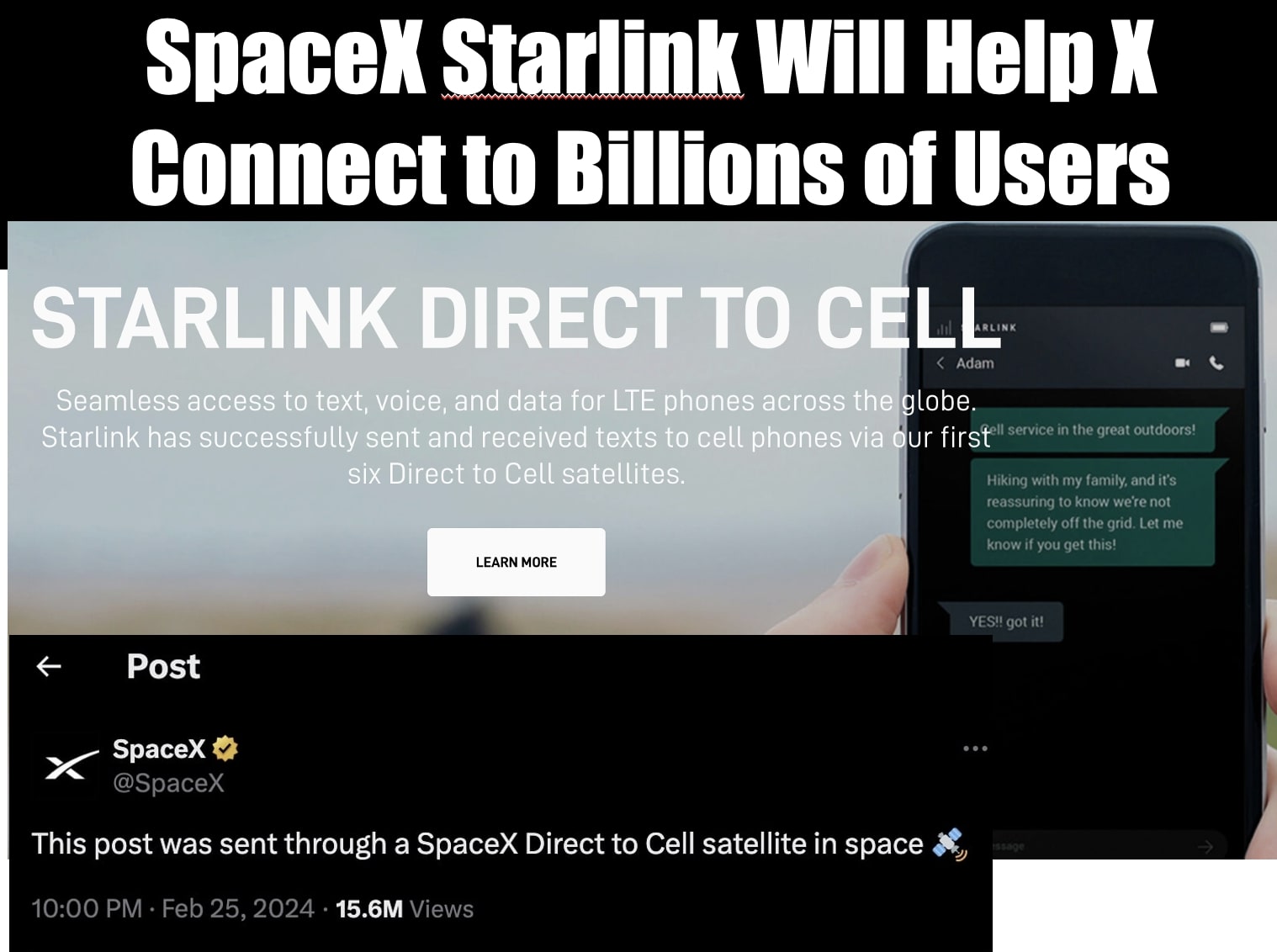A post was sent through a SpaceX Direct to Cell satellite in space. Starlink has over 5000 satellites in orbit. SpaceX will launch 2000-3000 Starlink v2 mini direct to cell capable satellites in 2024 on about 120 launches.
On January 2, 2024, SpaceX launched to orbit their first six Starlink satellites with Direct to Cell capabilities. Launch and early tests of the technology were all completed without issue. On Monday, January 8, less than 6 days after launch, they sent and received our first text messages to and from unmodified cell phones on the ground to the new satellites in space using TMobile network spectrum. This validates that our link budget closes, and the system works!
This post was sent through a SpaceX Direct to Cell satellite in space 🛰️
— SpaceX (@SpaceX) February 26, 2024
The Direct to Cell network will expand Starlink’s vision by providing ubiquitous connectivity and seamless access to text, voice, and data for LTE phones and devices across the globe. Text service begins this year, followed by voice, data, and Internet of Things (IoT) services in 2025. SpaceX will be able to provide X posting and reading via Starlink at about the same time as text access.
Developing a satellite network that connects to unmodified cell phones presents several new technical and regulatory challenges beyond those Starlink has already overcome in deploying a 5,000+ satellite constellation in a few years, serving more than 2.3 million customers across the globe.
The first challenge is transmitting sufficiently strong radio signals to and from cell phones that were not designed to connect to satellites, with very low gain antennas and transmit power (max 0.2 Watts). Our team developed custom silicon onboard the satellite that is optimized for this application and reduces power and cost on the satellite. SpaceX also developed large 2.7 meter x 2.3 meter advanced phased arrays that use extremely sensitive radio receivers and high-powered transmitters for communicating with cell phones from space. The antennas were designed to ride on the Starlink v2mini satellites and are reliably launched and deployed to low-Earth orbit every few days by the Falcon 9 rocket. SpaceX is uniquely positioned to rapidly scale out the first Direct to Cell constellation in mere months, due to their unique and unprecedented vertical integration controlling both launch and satellite production in addition to operations. In the future, they will launch Direct to Cell satellites on Starship to improve the
service even further and increase our launch cadence.
The vision is to connect everyone using their existing phones without needing a new phone, upgrades, or a special app, SpaceX decided to use standard LTE/4G protocols. Our satellites orbit hundreds of kilometers above the Earth’s surface at speeds of 7.7 km/s. As a result, compatibility with LTE timing, Doppler, and latency constraints are extremely challenging. For the vehicles to perform like a true cell tower in space, handoffs between vehicles and on the ground must be completely seamless to the user. To accomplish this, they architected the system including satellite altitudes, beam size and placement, elevation angles, and number of satellites, such that they are just at the edge of physics where LTE is achievable and reliable. They fly an advanced LTE modem onboard each satellite that operates like a cell tower in space.
The Direct to Cell network leverages the infrastructure SpaceX has built for Starlink over the past several years. Direct to Cell satellites plug into the existing Starlink satellite constellation via laser backhaul; meaning even our early satellites can provide services anywhere with regulatory approvals without requiring dedicated ground infrastructure. They also leverage all
the existing networking, ground stations, and Points of Presence (PoPs) Starlink has developed. The Direct to Cell data travels over Starlink’s core directly to the operator’s core, providing a seamless integration.
In August 2022, SpaceX announced their first partnership with T-Mobile, and have since announced deals with Rogers in Canada, Optus in Australia, One New Zealand, KDDI in Japan, Salt in Switzerland, and Entel in Chile & Peru.

Brian Wang is a Futurist Thought Leader and a popular Science blogger with 1 million readers per month. His blog Nextbigfuture.com is ranked #1 Science News Blog. It covers many disruptive technology and trends including Space, Robotics, Artificial Intelligence, Medicine, Anti-aging Biotechnology, and Nanotechnology.
Known for identifying cutting edge technologies, he is currently a Co-Founder of a startup and fundraiser for high potential early-stage companies. He is the Head of Research for Allocations for deep technology investments and an Angel Investor at Space Angels.
A frequent speaker at corporations, he has been a TEDx speaker, a Singularity University speaker and guest at numerous interviews for radio and podcasts. He is open to public speaking and advising engagements.


Kessler syndrome risk increases with every launch, even to SpaceX’s own rockets, but other countries are coming up fast with unmanned launches to the Moon and even small satellite orbit. Then, there’s the uncertain threat of Russian space-based nuclear weapons.
It’s not going to be that easy.
Is Kessler syndrome really a risk in low earth orbit with all the atmospheric drag?
If not, than Debris Storms are an even worse risk to Terran life. Not everything will burn up in the atmosphere with volume like that. Some may hit a plane, or even a house or person, eventually.